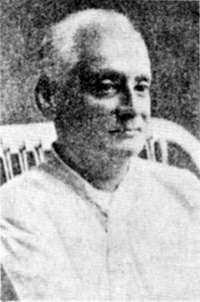Gaganendranath Tagore
| Gaganendranath Tagore | |
|---|---|
 | |
| Native name | গগনেন্দ্রনাথ ঠাকুর |
| Born |
September 17, 1867 Calcutta, Bengal Presidency, British India |
| Died | 1938 |
| Nationality | Indian |
| Known for | Painter, cartoonist |
| Movement | Bengal School of Art |
Gaganendranath Tagore (September 17, 1867–1938)[1] was an Indian painter and cartoonist of the Bengal school. Along with his brother Abanindranath Tagore, he was counted as one of the earliest modern artists in India.
Life and career
Gaganendranath Tagore was born at Jorasanko into a family whose creativity defined Bengal's cultural life. Gaganendranath was the eldest son of Gunendranath Tagore, grandson of Girindranath Tagore and a great-grandson of Prince Dwarkanath Tagore. His brother Abanindranath was a pioneer and leading exponent of the Bengal School of Art. He was a nephew of the poet Rabindranath Tagore and the paternal great-grandfather of actress Sharmila Tagore.

Gaganendranath received no formal education but trained under the watercolourist Harinarayan Bandopadhyay. In 1907, along with his brother Abanindranath, he founded the Indian Society of Oriental Art which later published the influential journal Rupam. Between 1906 and 1910, the artist studied and assimilated Japanese brush techniques and the influence of Far Eastern art into his own work, as demonstrated by his illustrations for Rabindranath Tagore’s autobiography Jeevansmriti (1912). He went on to develop his own approach in his Chaitanya and Pilgrim series. Gaganendranath eventually abandoned the revivalism of the Bengal School and took up caricature. The Modern Review published many of his cartoons in 1917. From 1917 onwards, his satirical lithographs appeared in a series of books, including Play of Opposites, Realm of the Absurd and Reform Screams.[2]
Between 1920 and 1925, Gaganendranath pioneered experiments in modernist painting. Partha Mitter describes him as “the only Indian painter before the 1940s who made use of the language and syntax of Cubism in his painting”.[3] From 1925 onwards, the artist developed a complex post-cubist style.
Gaganendranath also took a keen interest in theatre, and wrote a children's book in the manner of Lewis Carroll, Bhodor Bahadur (‘Otter the Great’).[4]
Works
- Tagore, Gaganendranath. 1917. Adbhut Lok: realm of the absurd. Calcutta: Vichitra Press. A portfolio of thirteen satirical pictures.
- Tagore, Gaganendranath. 1921. Naba Hullod: Reform screams; a pictorial review at the close of the year 1921. Calcutta: Thacker, Spink & Co.
- Tagore, Gaganendranath. 1930. Birupa bajra (Play of Opposites). Calcutta: Preonath Das Gupta for the Indian Publishing House.
- Tagore, Gaganendranath. Bhondor bahadur. Kolkata: Shishu Sahitya Samsad, 1998. Classic children's book
See also
References
- ↑ Sengupta, Subodhchandra; Bose, Anjali, eds. (2010). Sansad Bangali Charitabhidhan (5th ed.). Calcutta: Sahitya Samsad. ISBN 9788185626659.
- ↑ Terracciano, Emilia. "Biographical Notes". Bengal School Painting from the Collection of L.T.P Manjusri (1902-82). Oliver Forge Brendan Lynch.
- ↑ Partha Mitter (15 November 2007). The Triumph of Modernism: India's Artists and the Avant-Garde, 1922-1947. Reaktion Books. pp. 18–. ISBN 978-1-86189-318-5. Retrieved 27 April 2012.
- ↑ "Gaganendranath Tagore". Grove Art Encyclopaedia, Oxford University Press.
Further reading
- Kshitis Roy (1964). Gaganendranath Tagore. Lalit Kalā Akademi. Retrieved 27 April 2012.
- Partha Mitter, The Triumph of Modernism: India’s artists and the avant-garde 1922-1947, London, 2007
- Pūrṇimā Debī. (1975), Thākurabāṛīra Gaganaṭhākura, Kolkata: Rāmāyaṇī Prakaśa Bhabana, OCLC 20137196 (Memoir by Gaganedranath's daughter, in Bengali)
External links
- Gagnendranath Tagore
- Gaganendranath Tagore's Realm of the Absurd, Mukul Dey Archives
- Gaganendranath Tagore's works at V&A
- Gaganendranath's Moments with Cubism